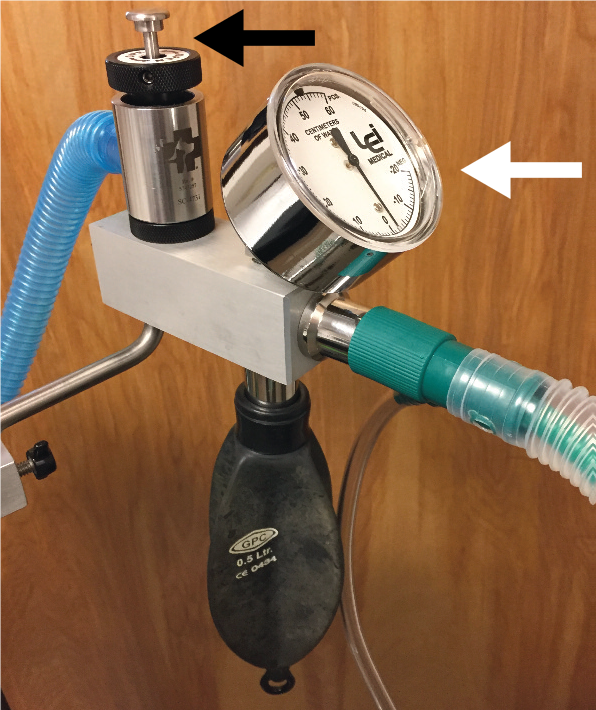Step 2: Equipment Preparation
Prior to the start of any general anesthesia or sedation-only procedure, it is critical to ensure that all equipment and monitors are turned on, are functioning, and have undergone appropriate safety checks. All necessary equipment, including the anesthesia machine, breathing circuit, endotracheal tube (ETT), intubation tools (e.g., laryngoscope), and anesthetic monitors, should be prepared. Anesthetic equipment is considered “life-critical” because the wellbeing of patients can be adversely affected if the equipment is not functioning optimally or is used incorrectly. Anesthesia machines, paired with breathing circuits (nonrebreathing circuit [NRC] or rebreathing circuit [RC]), are designed to deliver oxygen (O2) and inhalant anesthetic to the patient and to prevent rebreathing of carbon dioxide (CO2) by the patient. The machine and the breathing circuit become part of the patient’s respiratory system and can support, if working correctly, or impair, if working incorrectly, respiratory function. Two essential safety features to have on every anesthetic machine are (1) an in-circuit manometer and (2) a safety pop-off valve.

Bain non-rebreathing circuit (NRC) adapter with in-circuit manometer (white arrow) and safety pop-off valve (black arrow). Courtesy of Heidi Shafford, published in the Journal of Feline Medicine and Surgery, 2018;20:602-34.
A manometer allows safe delivery of manual and mechanical breaths, enables leak checking of the seal of the ETT cuff within the trachea, and allows for a visual indication of rise in airway pressure. Safety pop-off valves prevent excessively high airway pressure and potential barotrauma. These can be installed on most anesthesia machines for use with both types of breathing circuits.
Anesthesia personnel have a responsibility to understand the proper use and function of, and be able to set up, check, and troubleshoot, all necessary equipment prior to use. Equipment setup should be guided by checklists that dictate general equipment preparation tasks for the day (e.g., fill the CO2 absorbent canisters) and specific preparation tasks for each patient (e.g., pressure check the anesthesia machine prior to each use).
Step 2a -Oxygen tanks, CO2 absorbent, and vaporizer preparation
Ensure that O2 levels in the E-tank or hospital supply tank are >200 psi or that the oxygen generator is functioning properly. Fill the vaporizer with liquid inhalant. If the patient will be breathing through an RC, change the CO2 absorbent after 8 hr of use, which may be roughly daily or weekly, depending on the anesthesia case load.
Step 2b - Breathing circuit selection and connection
Connect the breathing circuit to the machine. When choosing a breathing circuit, note that NRCs are commonly used for cats and small dogs (patients <3–5 kg [6.6–11 lbs]) because, compared with RCs, they cause less resistance to breathing and have low equipment dead space, both of which are important considerations in small patients. Excessive equipment dead space leads to rebreathing of CO2 and subsequent hypercarbia/hypercapnia. Dead space should be kept to a minimum and should be ≤2–3 mL/kg, which is ≤20% of total tidal volume. The patient end of breathing circuits (where mixing of inspired and expired gases occurs) is a common source of dead space. Pediatric circuits, which have low dead space, are recommended for use in smaller patients. Rebreathing of CO2 in the NRC is prevented by high O2 flow rates, which also allows for a faster turnover in the change of anesthetic depth when adjusting the vaporizer setting. Thus, the O2 flow should be ~200–400 mL/kg/min when using NRCs.19 Flow adequacy should be monitored with a capnograph and adjusted to keep the inspired CO2 to <5 mm Hg. If any occlusion occurs in the expiratory limb of the circuit, the relatively high oxygen flow rates used in NRCs will cause rapid pressurization of the entire system and can lead to airway damage and/ or circulatory collapse within minutes. In addition, the oxygen flush valve should never be used in a patient breathing through an NRC because it directs a high-pressure flow directly into the patient’s airway, potentiating barotrauma. The risk of high airway pressure damage is increased in cats and small dogs because of their small lung capacity (~400 mL per average cat). For safety, a high-pressure alarm can be inserted in the expiratory limb of the breathing circuit. This does not allow escape of gas but emits a loud noise if the pressure in the circuit rises.

Rebreathing circuits (i.e., circle systems) with lightweight plastic rebreathing hoses and minimal dead space are typically used in patients >3–5 kg (6.6–11 lbs). Pediatric RCs typically have lower equipment dead space compared with hoses for adult patients and can be used for patients <3–5 kg (6.6–11 lbs) if NRCs are not available. RCs depend on functional one-way valves to ensure unidirectional gas flow and on CO2 absorbent to prevent rebreathing of CO2. Proper valve function can be assessed by breathing through the circuit while visualizing movement of the correct valve on inspiration and on expiration. During the maintenance phase, total O2 flow rate should typically be 20–40 mL/kg/min, with a minimum 500 mL/min to ensure accurate vaporizer output. The benefits of lower flow rates include decreased environmental contamination and decreased consumption of O2 and volatile anesthetic gases (i.e., inhalant anesthetic not inhaled by the patient). Lower flow rates also conserve moisture and heat. When using RCs, a minor disadvantage of lower flow rates is increased time to change anesthetic depth after changing the vaporizer setting.
Step 2c - Leak testing
Leak test the machine and circuit before anesthetizing each patient and after changing any breathing circuit components. This safety measure ensures that oxygen is flowing to the patient and that there is minimal risk of inhalant leakage. For this step, the adjustable pressure limiting, also called the pop-off valve, must be closed. Occlude the end of the breathing circuit and increase the O2 flow to raise the machine circuit pressure to 20–30 cm H20 on the manometer. The oxygen should be turned off, and the pressure manometer should remain steady. If no leak is detected, open the pop-off valve, and then release the breathing circuit occlusion. If a leak is detected, pull the machine from use and initiate troubleshooting procedures.
Step 2d - Scavenger system set-up
Ensure proper setup of the scavenging system to limit or eliminate personnel exposure to inhalant gases. The Occupational Safety and Health Administration provides advisory guidelines, although some US states have specific regulations regarding control of waste anesthetic gases. Active scavenging systems are far more effective than passive scavenging systems (e.g., activated charcoal canisters). More information on waste anesthetic gas is available through the American College of Veterinary Anesthesia and Analgesia.20
Step 2e - Intubation preparation
Prepare for airway management by choosing ETTs of appropriate sizes and intubation tools (e.g., stylets, laryngoscope), along with a face mask for preoxygenation prior to induction. Veterinarians have several options for intubation, including clear cuffed polyvinylchloride, silicone, and self-sealing baffled tubes. Supraglottic airway devices, which do not require intubation, are available for airway management in cats and rabbits. ETT elbow and capnograph adapters are a source of dead space. To decrease dead space breathing without increasing airway resistance, the diameter of the capnograph and elbow adapters should always exceed the internal diameter of the ETT. A single elbow adapter may add up to 8 mL of dead space, which can be excessive in small patients. Low dead space adapters are recommended.
Total Airway Control Devices
| Airway technique | Advantages | Disadvantages |
| Clear cuffed PVC or silicone endotracheal tube | Greater range of sizes to minimize resistance; ability to cut to minimize dead space, Murphy eye on most tubes to allow movement of gas in case of obstruction at end of tube | Greater likelihood for tracheal mucosal injury from cuff pressureDisadvantages |
| Self-sealing baffled endotracheal tube | Potentially more leak resistant | Limited sizes may result in increased resistance to ventilation in certain patients; cannot change length by cutting inducing potential for more dead space; no Murphy eye for alternate flow of gas in case of end of tube obstruction |
| Supraglottic airway device | Anatomically specific for use in some species; multiple sizes with minimal dead space; does not enter the trachea, therefore does not cause tracheal trauma; ease of use | Bulky – cannot use when performing oral radiography or surgery; easy to dislodge; obstructive breathing pattern if dislodged; must monitor CO2; expensive |
Anesthesia Equipment Safety Tips
- To improve anesthesia safety, include a manometer and a safety pop-off valve in the patient breathing circuit. The latter prevents a rapid increase in airway pressure due to a closed pop-off valve, thus decreasing the risk of barotrauma.
- Following the oxygen flow from the anesthesia source, through the anesthesia machine and breathing circuit, to the patient, then from the patient to the rebreathing bag (or reservoir bag on NRC) and finally to the scavenging system, is an effective way of learning the common components of the anesthesia machine and breathing circuit.





